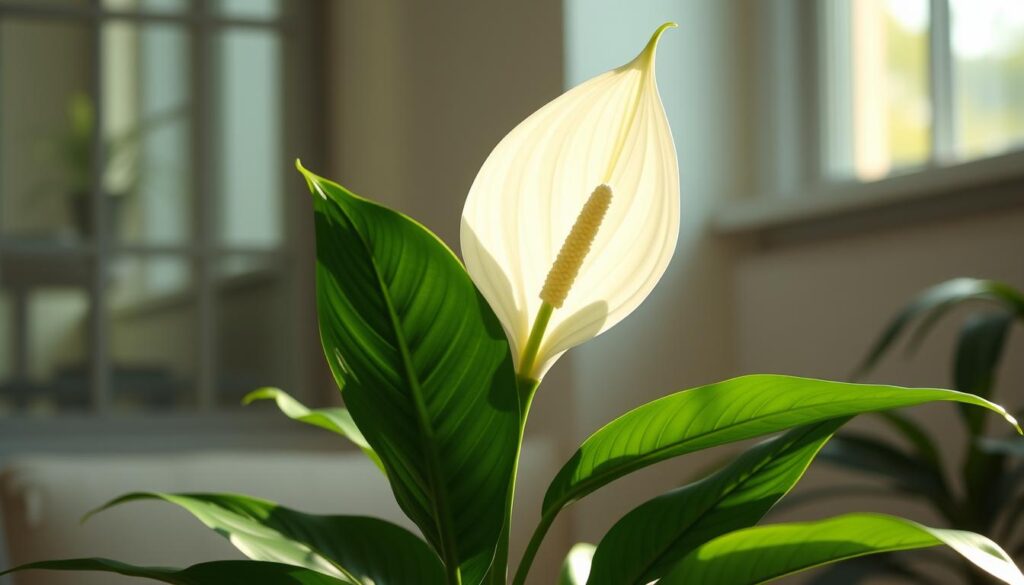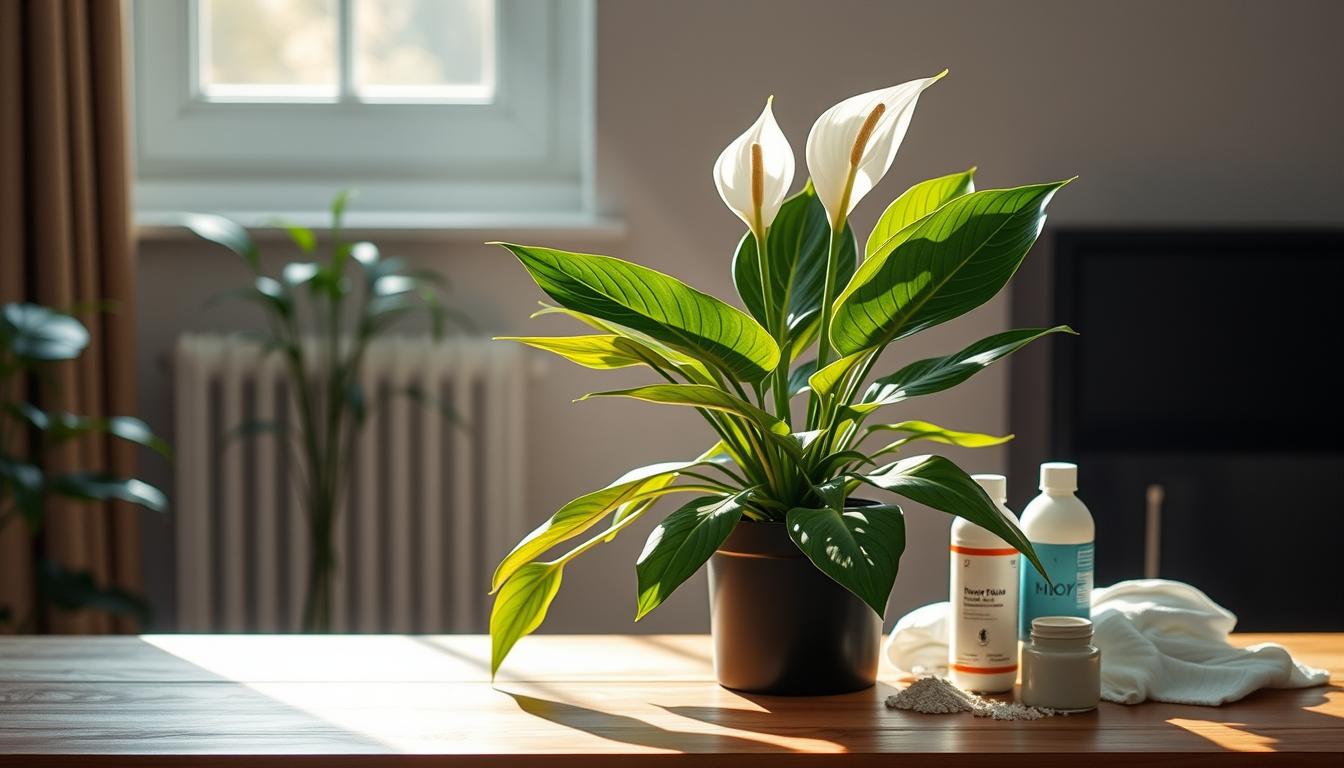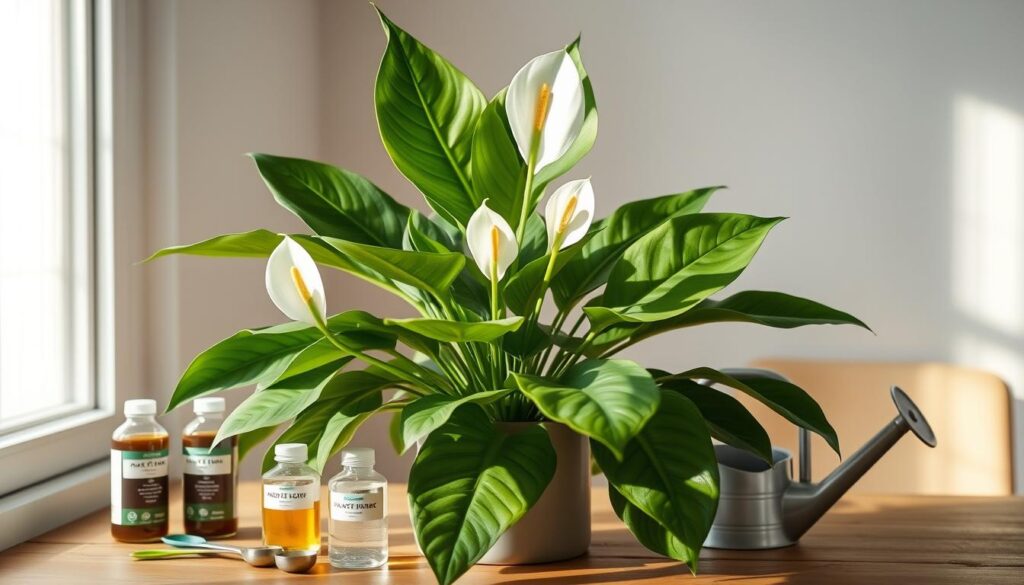The peace lily is great for beginners. It adds elegance to any room. It also purifies the air and has beautiful white flowers.
It’s easy to care for, perfect for busy people. This makes it a great choice for anyone starting with plants.
Having a peace lily brings many benefits. It makes your home look nicer and feels cleaner. It’s perfect for brightening up any room or office.
With the right care, your peace lily will bloom beautifully. It will make your space feel peaceful and elegant.
In this guide, you’ll learn how to care for your peace lily. You’ll find out about watering, fertilizing, pruning, and repotting. You’ll also learn about the best temperature, humidity, and light for your plant.
By following these tips, you’ll become a peace lily expert. Your plant will thank you. Let’s start our journey to caring for peace lilies and enjoy a beautiful indoor plant.
Understanding the Peace Lily Plant
Peace Lily plants are loved for their special features. They come from Central America and love warm, humid places. They do best in bright, indirect sunlight.
Peace Lilies can grow in different conditions. They can handle short dry spells but too much dryness hurts their leaves. They can grow up to 16 inches tall indoors. Some outdoor ones can have leaves up to 6 feet tall.
There are many Peace Lily varieties to pick from. Each has its own look and size. You can find everything from the Spathiphyllum wallisii to the exotic Spathiphyllum mauna loa.
What Makes Peace Lilies Special?
Peace Lilies have beautiful white flowers and dark green leaves. They are easy to care for. They need moist soil and indirect sunlight to thrive indoors.
Common Varieties of Peace Lilies
Some popular Peace Lily varieties are the ‘Petite’ and ‘Sensation’. The ‘Petite’ grows up to 10 inches tall. The ‘Sensation’ can reach 6 feet tall. These varieties add variety to your indoor garden.
Ideal Conditions for Your Peace Lily
To make your peace lily happy, you need to know what it likes. It loves bright, indirect light. This makes it perfect for rooms with east- or west-facing windows. Peace lilies also do well in temperatures between 65-80°F (18-27°C), which is common indoors.
Peace lilies like it humid, with humidity over 50%. To keep it humid, put the plant on a tray with water and pebbles. Or, use a humidifier. With the right light, temperature, and humidity, your peace lily will bloom beautifully.
- Give it bright, indirect light for growth and blooms.
- Keep the temperature between 65-80°F (18-27°C) to avoid damage.
- Make sure humidity is over 50% for its health and growth.
By following these tips, you can make your peace lily thrive. It will add beauty and calm to your home.
Watering Your Peace Lily
Watering your Peace Lily right is key to its health. Knowing how much water it needs is important. Too much water can hurt the roots, while too little can turn the leaves yellow. Check the soil by sticking your finger in it up to the first knuckle. If it’s dry, it’s time to water.
Peace Lilies like soil that drains well and should be watered when the top inch is dry. How often you water depends on the season and where it’s kept. In spring and summer, they need more water because it’s warmer and sunnier. Indoor Peace Lilies need less water because the soil dries slower.
How Often Should You Water?
How often you water can change based on the situation. Peace Lilies usually do well with weekly waterings, which is 52 times a year. But in winter, you can water them every two weeks, which is 26 times. The type of pot and soil also plays a role in how much moisture the soil holds.
Signs of Overwatering and Underwatering
Knowing the signs of too much or too little water is crucial. Yellow leaves and droopy plants mean the soil moisture is off. By following the right watering tips and watching for these signs, you can keep your Peace Lily happy and healthy.
| Season | Watering Frequency |
|---|---|
| Spring and Summer | Weekly (52 times a year) |
| Winter | Fortnightly (26 times a year) |
By following these tips and paying attention to your Peace Lily, you can have a beautiful plant. It will add elegance and peace to your space.
Nutrient Needs for Healthy Growth
To keep your Peace Lily happy, know what it needs. Use a balanced, water-soluble fertilizer in spring and summer. Fertilize every 4-6 weeks with indoor plant fertilizer. Make sure to dilute it to half strength to avoid harming the roots.
The Peace Lily fertilizing schedule changes with light. In bright light, fertilize every six weeks. For medium light, do it 2-3 times a year. In low light, fertilize once or twice a year.
Best Fertilizers for Peace Lilies
A 20-20-20 NPK ratio fertilizer is good for Peace Lilies. Look for indoor plant fertilizers with micronutrients. Always dilute the fertilizer to half strength and avoid too much.
Here are some key points to consider when fertilizing your Peace Lily:
- Fertilize every 4-6 weeks during the growing season
- Dilute the fertilizer to half the recommended strength
- Choose a balanced fertilizer with a 20-20-20 NPK ratio
- Avoid over-fertilization, which can cause brown edges or tips, yellowing leaves, and decreased growth
When and How to Fertilize
To ensure your Peace Lily gets the right nutrients, follow these fertilizing tips:
| Light Conditions | Fertilization Frequency |
|---|---|
| High Light | Every 6 weeks |
| Medium Light | 2-3 times a year |
| Low Light | Once or twice a year |
By following these tips and using the right best fertilizers, you can make a Peace Lily fertilizing schedule. This will help your plant grow well.
Pruning and Maintenance Tips
To keep your Peace Lily happy, you need to prune it often. This means cutting off dead or dying leaves and flowers. It helps your plant look good and grow new leaves.
Prune your Peace Lily every 6-8 weeks. Use clean, sharp scissors or pruning shears. This stops diseases from spreading.
When pruning your Peace Lily, check for pests or diseases. Look for yellow leaves, black spots, or white powdery patches. Catching these early stops them from harming your plant.
Some important maintenance tips are:
- Prune in early spring or summer for the best growth
- Take off yellow leaves, brown-tipped leaves, and old flowers for health
- Don’t prune too much, as it can stress the plant
By using these pruning techniques and maintenance tips, your Peace Lily will bloom beautifully all year. Always clean your tools and sterilize them with alcohol to avoid disease.
Regular pruning and maintenance are key for your Peace Lily’s health and beauty. By doing these things, you’ll have a stunning plant that adds elegance and calm to your home.
Recognizing Common Pests and Diseases
When you take care of your peace lily, knowing about pests and diseases is key. Pests like mealybugs, spider mites, and scale can harm leaves and flowers. It’s important to check your plant often to spot problems early.
Peace lilies can get sick too. Root rot happens when they get too much water. Leaf spot and powdery mildew are other diseases. These can cause spots and turn leaves brown or black.
To stop pests, use insecticidal soap or neem oil. Keeping your peace lily away from other plants helps too. For more info on treating diseases, check this resource. These steps will help your peace lily stay healthy.
Here are some important tips:
- Check your peace lily often for pests or diseases
- Use insecticidal soap or neem oil to fight pests
- Make sure air moves well and humidity is not too high
- Keep leaves dry to avoid bacterial blight
By following these tips, you can keep your peace lily safe from pests and diseases. Always make sure air moves well, water right, and check your plant often. This will help your peace lily stay healthy and strong.
Repotting Your Peace Lily
As you care for your Peace Lily, you might see it needs a change. Repotting is key to keeping your plant healthy and growing. But when and how to repot? The Peace Lily repotting might seem hard, but it’s easy with the right help.
Check if your Peace Lily needs repotting by looking for signs. These include wilting, yellow leaves, or roots coming out of the pot. The best time to repot is in spring, after it blooms. Pick a pot that’s only 1-2 inches bigger than the old one. Use a potting mix that drains well. Here’s how to repot your Peace Lily:
- Water your Peace Lily well before repotting to make the soil easier to handle.
- Gently remove the plant from its pot, being careful not to hurt the roots.
- Trim any dead or damaged roots, and cut back the plant to encourage new growth.
- Put the plant in its new pot, add fresh potting mix, and water well.
By following these steps and knowing when to repot, you’ll help your Peace Lily thrive. Keep an eye on your plant after repotting and adjust its care as needed. With the right care, your Peace Lily will keep growing, adding beauty to your home.
Encouraging Blooms Year-Round
To make your Peace Lily blooming, give it the right stuff. It needs lots of indirect light, the perfect temperature, and the right humidity. Also, feeding it regularly helps a lot. Use a balanced fertilizer every 6 to 8 weeks to help it bloom.
For caring for blooms, take off dead flowers. This helps new ones grow. Place your Peace Lily in bright, indirect light. Keep the temperature between 65-80°F (18-27°C). With good care, it will bloom all year, showing off beautiful white flowers for weeks.

- Watering your Peace Lily 2 to 3 times a week in bright light
- Misting the leaves daily to maintain humidity
- Providing a chilling period of 54°F (12°C) for a few weeks to stimulate blooming
Follow these tips to make your Peace Lily bloom all year. Enjoy its lovely flowers and fresh air.
Propagation Techniques for Peace Lilies
There are two main ways to grow Peace Lilies: division or leaf cuttings. Division is the most popular method. It lets you make more plants without spending more money. Wait until your Peace Lily is too big for its pot, usually in spring or summer.
Then, split the roots to make new plants. Make sure they get enough light and stay in the right temperature and humidity.
Timing is key for growing Peace Lilies. The best time is spring or summer when it’s warmer. But, since it’s always warm inside, you can grow them any time. Use a mix of potting soil, perlite, and coconut coir to keep the soil dry.
Keep the top soil dry before watering. Also, feed your new plants often. With the right care, your Peace Lilies will grow well. They will bloom and have lots of leaves. Follow these tips to enjoy your Peace Lilies for a long time.
| Propagation Method | Success Rate | Optimal Time |
|---|---|---|
| Division | High | Spring or Summer |
| Leaf Cuttings | Low | Any time of the year |
Celebrating Your Peace Lily’s Beauty
As you’ve cared for your peace lily, you’ve seen its beauty grow. Its leaves and white blooms are stunning. Now, it’s time to show off your plant’s beauty in fun ways!
You can display it in creative spots. Or share your plant’s story with others. There are many ways to celebrate your peace lily’s beauty.
Creative Ways to Display Your Peace Lily
Put your peace lily on a pedestal or shelf. This lets its leaves and blooms shine. Or hang it in a basket for a lush look.
For a cool display, group your peace lily with other plants. This creates a beautiful indoor garden.
Sharing Your Peace Lily Journey with Others
Sharing your peace lily’s story with others is rewarding. Join online forums or social media groups. Here, you can share tips and stories with fellow plant lovers.
Posting photos and updates about your plant can inspire others. It also builds a community around your beloved houseplant.




